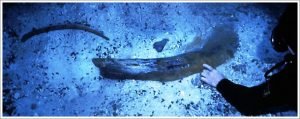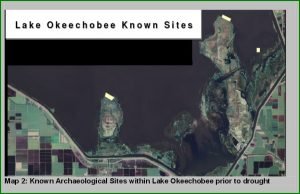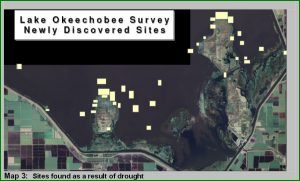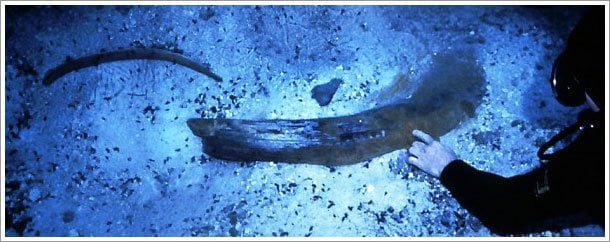Anthropologists believe that mankind has lived somewhere in southern Florida for at least 12,000 years. 1 Its sub-tropical climate, abundance of water and fertile peat soils produces a diverse range of animal and vegetative food sources for humans year round. However, to date no Paleo-American artifacts have been discovered in or along the shores of the lake. Such evidences of the past are probably buried deep under the peat in scattered locations. They have been found in abundance about 88 miles (110 km) to the northwest in two natural springs near Sarasota, FL.
The Florida Peninsula during the Pleistocene period was a very different environment than today. 2 Because much of the amount of water on the surface of the Earth was frozen in ice sheets during the last glacial period, the sea level was at least 330 ft (101 m) lower than today. The Florida Peninsula had about twice the land area of today. Even as late as 4000 BC the coastline extended about 40 miles (64 km) into what is now the Gulf of Mexico. Most of the archaeological record of mankind’s early occupation of Florida is therefore buried under the ocean floor.
The water table in all of the Florida Peninsula during the last Ice Age was much lower than today, and its climate was cooler and much drier. 2 It is believed that the interior of the peninsula and South Atlantic Coastal Plain was a temperate desert, much like the coastal plain of Peru and Chile today. These were climatic conditions that caused the interior of the peninsula to be an arid, inhospitable location for permanent human habitation, but also caused the areas near the current coastline and now buried under ocean water to contain grassy savannas around freshwater sources that were ideal for large herds of ruminants and their predators.
There were few running rivers or springs in the part of Florida that is now above sea level. 2 The few water sources in the interior of Florida were rain-fed lakes and water holes perched on relatively impervious deposits of marl and deep sinkholes partially filled by springs. The water level in most sinkholes 12,000 years ago was about 98 ft (30 meters) lower that it is today. Their appearance would have been identical to the famous cenotes of the northern Yucatan Peninsula.

Pleistocene Age timbers, human skeletons and human artifacts have been found in at least two sinkhole springs in the region, west of Lake Okeechobee – Warm Mineral Springs and Little Salt Springs. 3 There are probably many more springs in the region, which contain skeletons and artifacts, but they have not been studied. Timbers associated with human skeletons found at the bottom of the Warm Mineral Springs were radiocarbon dated to about 8000 BC.
There have been extensive discoveries of PaleoAmerican (Late Ice Age~Clovis) artifacts in northern and central Florida. These are typically found in the bottoms of springs or on the banks of ancient rivers. At the Topper Site, 400 miles (640 km) to the north of Lake Okeechobee, University of South Carolina archaeologists found definite pre-Clovis artifacts that dated from around 15,000 years ago, and more controversial flint flakes that looked like tools, which were in association with charcoal dated to be 50,000 years old. 4
It is quite plausible that the milder climate of the southern Florida Peninsula would have attracted even larger populations of humans, especially those who lived off of seafood. The artifacts and skeletons that would prove their presence have not been found. If they exist, they are probably buried in the sediment at the bottom of the ocean or under 15+ feet (5 m) of Lake Okeechobee peat.

Preliminary Results of the Boyer Survey: An Archaeological Investigation Of Lake Okeechobee

Preliminary Results of the Boyer Survey: An Archaeological Investigation Of Lake Okeechobee
Citations:
- Everglades Forever. Web site sponsored by the State of Florida.[↩]
- Means, Guy H. (2010). “Florida’s Geologic History“. Florida Dept. of Environmental Protection.[↩][↩][↩]
- Warm Mineral Springs website[↩]
- Allendale PaleoAmerican website[↩]


